By: Manpreet Kaur
Key Takeaways:
- The packaging industry needs to prioritize sustainable practices in order to reduce harm, conserve resources, and promote biodegradability.
- Megatrends such as sustainability and digitalization are changing the packaging landscape. This is challenging industry leaders to innovate while also considering complex consumer demands.
- Trends such as plastic recycling, the resurgence of paper and glass packaging, bioplastics, and minimalist design are driving the industry towards more eco-friendly solutions.
- Smart label technologies offer exciting opportunities for enhanced traceability, transparency, and accountability.
In today’s world, people are more concerned about environmental sustainability than ever before. The packaging industry is at a crucial point in its development, with many opportunities for innovation and challenges to face. Sustainability and the digital revolution, particularly in e-commerce, are two of the main trends that are shaping the industry. Industry leaders need to balance eco-consciousness with digital transformation to succeed. Sustainable packaging design is at the core of this transformation, as it aims to minimize environmental impact and reshape consumer perceptions and brand loyalty.
For more details on SpendEdge services
Why Sustainable Packaging Matters?
To keep up with the evolving market trends, packaging industry has gone through a major shift, owing to the environment. That is where we see sustainable packaging today and it matters for various reasons. Some of the main reasons are as mentioned below:
- Environmental Impact Reduction: Sustainable packaging plays a vital role in mitigating environmental harm by conserving natural resources and utilizing recycled materials, thereby reducing carbon footprints and promoting biodegradability.
- Employee Well-being and Safety: By eschewing toxic materials like Styrofoam, sustainable packaging safeguards the health and safety of employees involved in the packaging process.
- Enhanced Brand Perception: Embracing sustainable practices enhances brand reputation in consumers’ eyes, fostering loyalty and trust through a commitment to environmental stewardship.
- Sales Boost: Customer satisfaction stemming from sustainable initiatives bolsters brand image, leading to increased sales and market competitiveness.
- Long-term Business Sustainability: By diminishing reliance on finite resources, sustainable packaging ensures business continuity and fosters innovation through the use of recycled materials.
- Cost Efficiency: Utilizing reused and recycled packaging materials not only promotes environmental responsibility but also translates into cost savings for businesses.
Emerging Packaging Trends Revolutionizing Global Commerce
Plastic Recycling Takes Center Stage:
The packaging industry is becoming increasingly aware of the environmental issues associated with plastic waste. As a result, the industry is placing a significant emphasis on recycling plastics. This trend not only involves encouraging consumers to recycle plastic packaging but also implementing practices within the industry to use recycled plastic materials in packaging production. By prioritizing plastic recycling, the industry aims to reduce the environmental impact of plastic waste and promote a more sustainable approach to packaging.
Renaissance of Paper & Glass Packaging:
Paper and glass packaging materials are becoming more popular due to various reasons. With people being more conscious about the environment, they are increasingly seeking greener alternatives to plastic packaging, which has resulted in a growing demand for paper and glass options. Besides, paper and glass offer unique aesthetic qualities that appeal to consumers looking for more traditional and visually appealing packaging solutions. The resurgence of paper and glass packaging reflects a broader shift towards sustainability and a desire for packaging materials that are both functional and environmentally friendly.
Bioplastics:
Bioplastics are a major breakthrough in the packaging industry. Unlike traditional plastics that come from fossil fuels, bioplastics are made from renewable sources such as plants and other organic materials. This makes them biodegradable and compostable, offering a more sustainable alternative to conventional plastics. As companies strive to reduce their environmental impact and meet consumers’ demand for eco-friendly packaging options, bioplastics are becoming increasingly popular.
The Revival of Reusable Packaging:
The use of reusable packaging solutions is gaining popularity as more businesses and consumers recognize the importance of reducing waste and promoting circular economies. By using packaging that can be returned, refilled, or repurposed, companies can reduce the amount of packaging waste generated and decrease their reliance on single-use materials. This shift towards reusable packaging demonstrates a growing awareness of the need for more sustainable packaging practices and a willingness to embrace innovative solutions to address environmental concerns.
Embracing Minimalism in Product and Packaging Design:
Minimalism is gaining popularity in the product and packaging design industry as companies aim to simplify their offerings and minimize waste. The minimalist design prioritizes simplicity, functionality, and eco-friendliness, resulting in packaging that is efficient, sleek, and sustainable. By implementing minimalist design principles, companies can create packaging that not only attracts customers but also demonstrates their commitment to responsible consumption and sustainability.
Leveraging Smart Label Technologies for Sustainability:
Smart label technologies are being utilized to enhance sustainability efforts in packaging by providing innovative solutions for traceability, authenticity, and environmental impact monitoring. These technologies, such as QR codes, RFID tags, and NFC chips, allow consumers to access information about the origin, production process, and environmental footprint of products and packaging. By integrating smart labels into packaging, companies can improve transparency, promote accountability, and enable consumers to make more informed purchasing decisions that align with their values and sustainability objectives.
SpendEdge: Procurement and market intelligence solutions

Supplier Sustainability Analysis:
Our supplier sustainability analysis service involves evaluating suppliers based on their environmental, social, and governance (ESG) practices to ensure alignment with the client’s sustainability goals. We conduct in-depth assessments of suppliers’ sustainability initiatives, including their use of renewable resources, waste management practices, labor conditions, and ethical sourcing policies. Through this analysis, we identify high-performing suppliers with strong sustainability credentials, helping clients build a more responsible and resilient supply chain.
Best Practices Development:
We assist clients in developing best practices for supplier management, drawing on industry benchmarks and proven strategies. Our team collaborates with clients to understand their unique requirements and challenges, then develops tailored best practices that optimize supplier relationships, enhance transparency, and drive continuous improvement. These best practices cover various aspects of supplier management, including supplier qualification, performance evaluation, risk mitigation, and collaboration for innovation.
Supplier KPIs and SLAs:
We work closely with clients to define key performance indicators (KPIs) and service level agreements (SLAs) that align with their strategic objectives and support effective supplier management. Our experts help identify meaningful metrics to measure supplier performance, such as on-time delivery, product quality, responsiveness to inquiries, and adherence to sustainability standards. We also establish SLAs that clearly outline the expectations and responsibilities of both parties, ensuring accountability and driving performance improvement.
Request a free trial of our services at SpendEdge that can help you with procurement
Conclusion
In conclusion, as global consciousness about environmental sustainability rises, the packaging industry finds itself at a critical juncture. The convergence of megatrends like sustainability and digital transformation presents both challenges and opportunities for innovation. Embracing sustainable packaging practices is not just about reducing environmental impact; it’s about reshaping consumer perceptions, fostering brand loyalty, and driving long-term business sustainability. By adopting eco-friendly solutions, leveraging emerging trends, and implementing robust supplier management strategies, businesses can not only meet evolving market demands but also champion genuine environmental stewardship while thriving in a rapidly changing landscape.

Get in touch with our professionals and see how it helps your business
Author’s Details
Manpreet Kaur
Assistant Manager Presales – Sourcing and Procurement Intelligence
Manpreet is a presales specialist at Infiniti Research and has expertise in sales, business strategy execution, and innovative solution design. She is actively involved in supporting clients from F&B, CPG, Healthcare, Pharma, Chemicals, BFSI, Oil & Gas and Automotive sectors.




